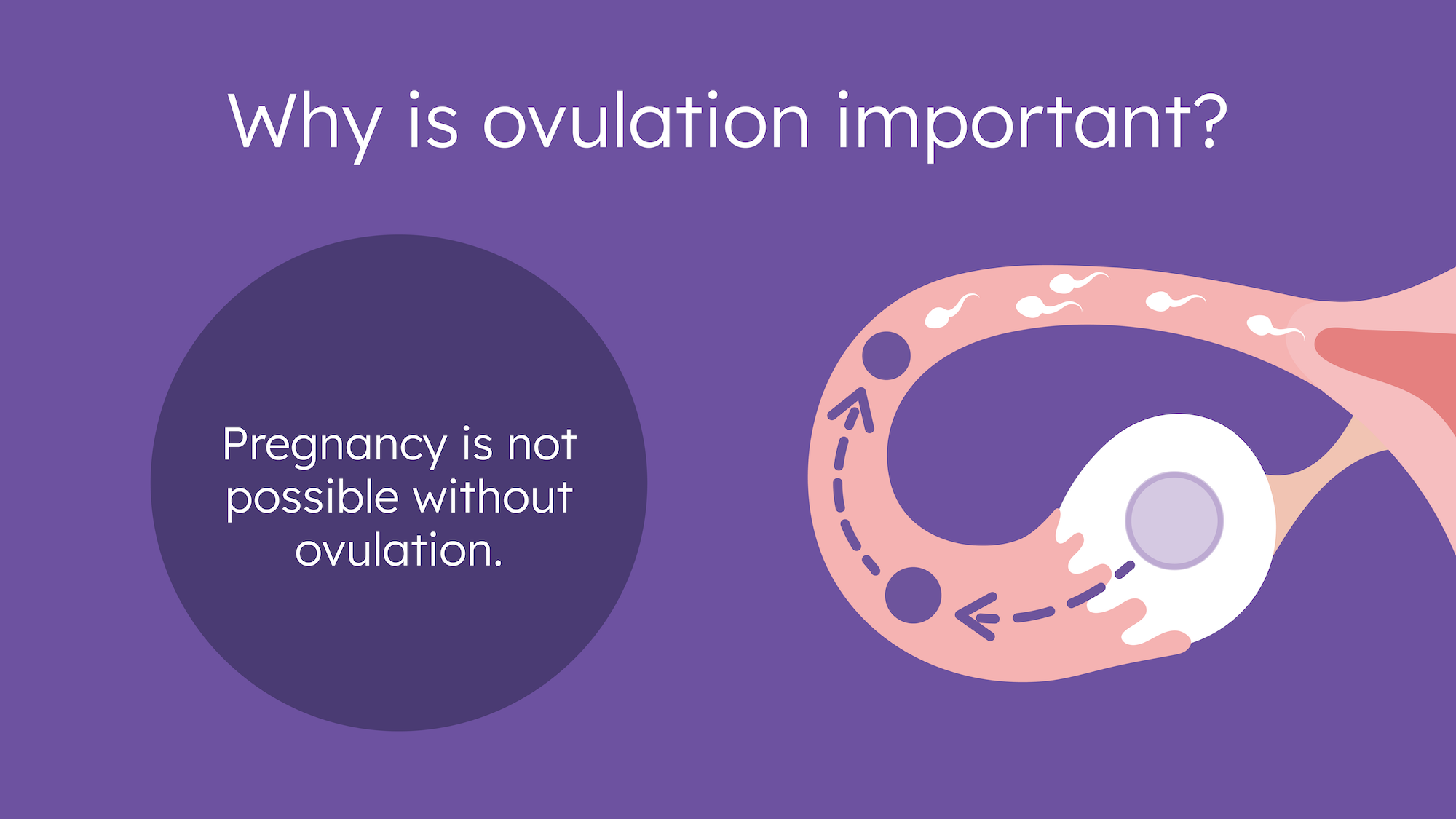Updated on 12/11/23

If you’re a regular on the Proov blog, you probably know we love to talk about ovulation. After all, we know that healthy ovulation is a critical piece to the pregnancy puzzle!
Understanding if you’re ovulating — and some reasons why you’re not ovulating — can give insight into your overall health and help you get pregnant faster.
Why is ovulation important?
First and foremost, you cannot get pregnant without ovulating. Without ovulation, there’s no egg and conception just isn’t possible.
In fact, the health of your ovulation is equally as important as the act of releasing an egg itself. After ovulation occurs, the empty follicle from which the egg was released (also known as the corpus luteum) produces progesterone. This hormone stabilizes the uterine lining and makes it “sticky” enough to allow for the best possible chance at conception.
A “sucessful” ovulation occurs when progesterone rises post-ovulation and remains adequately elevated for several days during the luteal phase. Without enough progesterone, ovulation is considered weak and it can be more difficult to get pregnant.
But ovulation isn’t just important when you want to have a baby. Ovulation is a major sign of overall health and is proof that your endocrine system is well balanced. While anovulatory cycles (cycles when ovulation doesn’t occur) may occur from time to time even to women having regular periods, recurrent lack of ovulation may signal autoimmune, genetic, or nutritional disorders.
Additionally, ovulation is triggered and controlled by our hormones. A lack of ovulation may be a sign of a greater hormonal imbalance. A hormonal balance is important since hormones regular all our bodily functions and are essential for our health and wellbeing. If you suspect you’re not ovulating consistently, we recommend consulting your doctor.
What are some possible reasons I'm not ovulating?
Here are four possible reasons you’re not ovulating:

1. PCOS
Polycystic Ovarian Syndrome (PCOS) is by far the most common cause of anovulation. Although PCOS is a frequent endocrine dysfunction affecting up to 28% of women of reproductive age, it is still highly underdiagnosed due to lack of consensus regarding the diagnostic criteria. According to studies, most PCOS patients go years before being properly diagnosed.
Women with PCOS deal with abnormally high levels of androgens (male sex hormones), which cause a hormonal imbalance that prevents them from ovulating. Lack of ovulation leads to low (or no) progesterone and this low progesterone then leads to high estrogen levels that may prevent ovulation from happening next cycle.
2. Hormonal imbalance
When hormonal imbalances affect the balance between estrogen and progesterone, they can prevent ovulation from occurring. When your body doesn’t produce enough progesterone post-ovulation, this may lead to estrogen dominance. Estrogen in excess may act as “natural” birth control, preventing ovulation from occurring.
3. NSAIDs
Nonsteroidal anti-inflammatory drugs (NSAIDs) are — as their name states — anti-inflammatories and when used regularly, they may prevent ovulation from happening. This is because ovulation is similar to an inflammatory response.
In fact, many fertility clinics use NSAIDS as LH (luteinizing hormone) blockers during ovulation induction treatments, to make sure the patient isn’t going to ovulate before the follicles are mature. If you are concerned about NSAIDs, we recommend consulting your doctor in order to find more suitable therapies to replace NSAIDs.
4. Stress
Stress management is certainly easier said than done. However, when we harbor stress for long periods of time, it may impact our endocrine system and cause a hormonal imbalance. When we are stressed our bodies produce cortisol, the “stress” hormone, that heightens our “fight or flight” response to help us appropriately act when in danger.
Chronic stress leads to a prolonged elevation of cortisol levels, which in turn can lower the levels of your reproductive hormones. How? Both cortisol and progesterone are made from cholesterol. When your body senses “danger” (i.e. high amounts of stress) it will prioritize production of cortisol over the production of progesterone. As we previously mentioned, low levels of progesterone can lead to higher levels of estrogen, which may inhibit ovulation.
How can I tell if I'm ovulating?
There are several ways you can confirm ovulation took place:

1. Basal body temperature (BBT) tracking
BBT tracking is a simple and inexpensive technique that involves monitoring your basal body temperature (your lowest resting body temperature) in order to detect hormonal changes during your cycle. Right before ovulation, your BBT should dip. Then after ovulation, it should rise and remain elevated during the luteal phase.
This method only works if you start tracking your temperature on cycle day 1 and continue to track religiously every day when you wake up, before getting out of bed, and without moving around too much. You may find you need to track BBT for a few cycles before being able to detect a pattern.
One of the downsides of BBT is that our body temperature is easily influenced by many factors, such as room temperature, sickness, alcohol consumption, smoking, and even cuddling overnight. BBT also does not measure your hormones, so it gives no insight into ovulation health.
2. Ultrasound
Ultrasounds are the standard reference for detecting ovulation and are performed by a specialized technician or an OB-GYN . Ultrasounds confirm ovulation by detecting the formation of the corpus luteum in the place of the empty follicle from which the egg was released and by noticing a change in the aspect of the endometrial lining.
This method is not broadly used due to it being invasive, expensive, and inconvenient. Like BBT, ultrasounds don’t measure hormones and cannot provide information about ovulation health.
3. Serum progesterone blood test
Serum progesterone is usually tested on cycle day 21, which is about 7 days post ovulation, when progesterone should be elevated.
However, testing serum progesterone on day 7 past ovulation may be more accurate than cycle day 21. This is because not every woman ovulates on cycle day 14, meaning 7 days post ovulation could fall before or after cycle day 21. A normal cycle may last anywhere between 21 to 35 days.
Another issue with serum progesterone testing is that progesterone is released into the bloodstream in a pulsatile nature (i.e. in periodic pulses). Due to this, progesterone levels are known to fluctuate up to 8 fold during a 90-minute period and one single value can give you incomplete results about your progesterone levels. The only way to understand your progesterone levels and ovulation health over time is by getting several blood draws over the luteal phase.
Still, if you want to make sure an egg was released, a single blood level over 5ng/mL should be able to confirm that.
4. Proov PdG Tests
Proov PdG tests measure PdG the urine metabolite of progesterone. Once it circulates through your blood, progesterone is metabolized by your liver and gets excreted in urine. Science shows that PdG levels tested in first morning urine correlate with blood levels and show more of an average of your progesterone levels in blood from the previous 24 hours.
The Proov PdG testing protocol recommends testing during 4 days of cycle, starting day 7 past peak (with peak being the day of your first positive LH test) and continuing daily through 10 DPP. Compared to a single progesterone blood test, Proov tests will not only confirm ovulation occurred, but will give insight into the overall health of your ovulation.
A successful ovulation refers to an ovulatory event in which an egg is released and PdG levels remain adequately elevated for long enough to allow for the best possible chance at conception. Weak ovulation occurs when not enough PdG is produced after ovulation and can make it more difficult to get pregnant.
While a single positive PdG test confirms ovulation, we like to see 3-4 positive Proov PdG tests (with a positive result on 10DPP) to confirm that ovulation was successful. Anything less than this may indicate weak ovulation which can make it more difficult to successfully conceive.
Confirming ovulation is one of the first and most important steps on your TTC journey and luckily, Proov is here to help!














